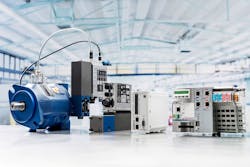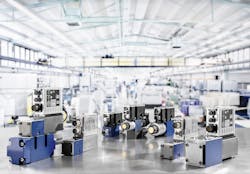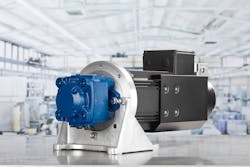The fusion of the physical world of production with the virtual world of information technology into Industry 4.0 is becoming increasingly important. The requirements placed on automation technology have been clearly defined: Decentralized intelligence and autonomous behavior, open communication standards, rapid networkability, and context integration in real time.
Together with digital control technology and open communication, hydraulics meets these requirements. Industry 4.0 also opens the physical advantages of hydraulics, such as high-power density, modular design, and robust, long-lasting performance to networked solutions.
The crucial step for integrating hydraulics into Industry 4.0 has already been taken: connecting hydraulic actuators to digital control electronics to shift functions to software. All of the features of the fluid technology are already stored in the software in the form of algorithms. They automatically offset the non-linearity of hydraulic drive technology.
Controller modules to support functions such as the transition from path control to force control or for synchronized motion, e.g., in presses, come pre-programmed. The advantage of this decentralized intelligence is that the hydraulic drives behave autonomously and adapt to changing process parameters on their own.
Software for Quick Networking
Bosch Rexroth has been a leader in introducing and advancing distributed, drive-based intelligence in multiple technologies, including hydraulics. Beginning in the early 1990s, the company introduced the first electrohydraulic linear axes with decentralized intelligence.
Bosch Rexroth has consistently invested in developing this capability, drawing on decades of practical experience to improve subsequent software generations. For example, Rexroth pre-defined the default hydraulic functions in the company’s best-in-class controllers so that end-users can configure them directly.
This makes startup of systems using hydraulic axes simpler and easier, and allows hydraulic solutions to be quickly networked and optimally calibrated online to meet individual requirements.
Drives with Decentralized Intelligence
Variable-speed pump drives open up additional options in the area of decentralized intelligence. They combine the benefits of state-of-the-art drive electronics with hydraulics. The drives in the Rexroth Sytronix family variable speed pump drive systems generate flow as needed and reduce power consumption in the hydraulics compared to conventional solutions by up to 80%.
Depending on the application, the Sytronix can take over the positioning of the cylinder directly. This reduces system costs, increases flexibility and simplifies start-up.
Rexroth continues to expand this approach to decentralized hydraulics with self-sustaining hydraulic linear axes. These ready-made cylinder assemblies come with their own fluid circuit with variable-speed pump. The cylinder generates linear movements without wear and is protected from overloading.
Self-sustaining axes are modular and can be installed as simply as electric drives: A cable just has to be connected to the power supply and the axis connected to the control system. The result: these axes have all of the functions of purely electric drives, as well as offering all of the benefits of hydraulics, including wear-free, high power density.
Basic Requirements for Open Standards
There is growing agreement in many automation and manufacturing sectors that, to fully realize the potential of Industry 4.0, there needs to be broad-based deployment of standardized communication protocols and programming languages.
Today’s established field bus systems already connect various technologies such as electric drives, hydraulics and pneumatics with the control system. Numerous machine manufacturers have already taken it one step further and switched to real-time Ethernet protocols such as Sercos, Ethernet IP, and Profinet.
In line with this industry direction, Rexroth not only supports bus connections, but also real-time connection to hydraulics through multi-Ethernet interfaces for the variable-speed pump drives and motion-controller systems currently offered.
These include all current real-time protocols such as Sercos, EtherCat, Ethernet IP, Profinet RT, and VARAN—all interfaces made available on one controller component. Control systems and higher systems thus have total access to the hydraulics and allow system integration regardless of manufacturer.
Open standards also refer to programming. The PLC languages under IEC 61131 have already become standard in machinery and plant engineering. Industry 4.0 requires more. Rexroth has been the first control system manufacturer to bridge the gap between the worlds of automation and IT with Rexroth’s Open Core Engineering solution.
This platform allows automation systems to be independently programmed in high-level languages. To achieve this, Rexroth opened the core of its PLC systems. In initial applications, machine manufacturers completely skipped PLC programming and use smartphones or tablets for startup, in-service optimizations, and diagnostics for their application.
Remote Diagnostics and Condition Monitoring
Connecting hydraulics via Ethernet unlocks a broad range of remote diagnostics and remote maintenance options. All control electronics are uniquely identifiable. With the proper authorization, technicians can query device data regardless of their physical location, and even change parameters online.
Decentralized intelligence also opens up new remote-condition monitoring capabilities. The electronics analyze sensor signals and the software determines the current operating status of the hydraulic system. If the measured values exceed defined tolerances, the system warns of reaching critical states. This allows maintenance technicians to take upcoming action in the windows that have already been planned before the machine shuts down.
Drive Physics No Longer “Technology-Dependent”
With decentralized intelligence and open standards, the software for hydraulic systems detects changing context of the product being worked on, and automatically adjusts the motion sequences. Drive physics no longer play a role for the higher control system: It does not matter whether the motion is electrical, electromechanical, or hydraulic—the drive has the intelligence to adapt motion of the axes it is driving to functional requirements.
This means, for example, that hydraulic press stations can read RFID product data and flexibly adjust the press capacity to the individual workpieces without the need for an operator or higher control system to intervene.
Through these developments, particularly in the area of making hydraulics motion control both decentralized and as intelligent as electric drive and motor solutions, hydraulics now matches electromechanical systems in terms of automation and the ability to meet the requirements of Industry 4.0.
In addition, intelligent electrohydraulics adds the physical advantages unique to hydraulics: high power density, competitive precision motion, and reliable, long-lasting operation. It makes hydraulics ready and well-suited to integrate into current and future Industry 4.0 concepts when combined with electronics, software, and open standards.
Markus Rukaber is head of sales-related product management in machinery applications and engineering at Bosch Rexroth GmbH, Lohr, Germany. For more information, visit www.boschrexroth-us.com.





